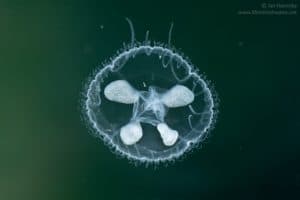Our lakes and rivers might seem placid from the surface, but if we take a glance underwater a surprisingly vibrant universe greets us. Fishes, crustaceans, plants, turtles, and snakes oh my! With all this life so readily apparent, what might we find if we take more than a glance?
Anna Orlando of Oakland County did just that, and she found the last thing we might expect: jellyfish! Anna found and identified the jellies before sharing her find with her mother Laurie. Laurie is our lake monitoring volunteer on Willow Lake where the jellyfish were found, and the two were gracious enough to share video of the jellies with us at HRWC. When we think of jellyfish, we think of elegant schools of marine jellies in the wide open ocean, perhaps ambling alongside whales and sea turtles. But what Anna and Laurie found was quite different.
Although the penny-sized freshwater jellyfish (Craspedacusta sowerbii) share many traits with marine jellyfish, including a round and nearly transparent body with a halo of tentacles, it is argued that freshwater jellyfish are more closely related to other gelatinous freshwater critters, like the hydra. Regardless they lead a life similar to many jellyfish, using stinging tentacles to paralyze aquatic insects and other small prey, then drawing them up into the body for digestion. Don’t fear! The stingers of these minute jellyfish are much too small to pierce human skin.

Freshwater jellyfish are thought be very common in lakes, ponds, and slow moving rivers yet are rarely spotted. There are a few reasons for this. For one, these creatures are tiny, composed of 99% water and nearly transparent, making them difficult to spot unless they are clustering together in what we call “blooms”. Secondly, we are only seeing one stage of a multi-stage life cycle. The tentacled saucers are called “medusae”, and are the sexually reproductive stage of the life cycle. During other life stages, freshwater jellyfish are virtually microscopic and impossible for a casual observer to detect.
C. sowerbii are not native to the United States. In fact, they originated in China before spreading across the globe by the early 1900s, likely through the aquarium trade. Despite being non-native to the Americas, peach blossom fish (as freshwater jellies are known in China) do not appear to threaten our local ecosystems. Because of that, we do not label them invasive, but rather a harmless “exotic” species.
In Michigan, freshwater jellyfish were identified for the first time in our very own Huron River in the 1933. Since then, they have been found in countless lakes and waterways across the state, including the nearby Clinton River; the Flint, Tittabawassee, and Au Sable Rivers to the north; and our big lakes, particularly St. Clair and Lake Huron.
The next time you find yourself paddling a quiet corridor of the Huron or visiting any of Michigan’s other beautiful bodies of water, take a closer look. You might just spot one of these delicate curiosities!
-Niklas Krantz is our Cooperative Lakes Monitoring Program Invasive Plants Intern this summer. He is majoring in Biological Sciences at Wayne State University. You can catch Nik featured in a recent story from the Environment Report, “Bugs can tell us whether a river is healthy,” by Lester Graham.



